Acquisitions: Water pipes from China
Auteur:
Don Duco
Original Title:
Aanwinsten: Waterpijpen uit China
Année de publication:
2009
Éditeur:
Pijpenkabinet Foundation
Magazine:
Nieuwsbrief Pijpenkabinet
Description :
Discussion of three types of water pipes characteristic of the Chinese smoking culture.
In many places around the world two main types of pipes are known: the traditional smoking pipe and the water pipe. Even linguistically there is a main division, not known in our regions, distinguishing the dry and the wet pipe. Of course these are the warm and dry, dusty areas where the use of a water pipe for cooling and filtering the smoke is relevant. In this issue of the Newsletter we like to present three water pipes, recent acquisitions. They all originate from China, although their shape and appearance differs, making an interesting comparison.
The so-called opium pipe
This pipe can be called the most typical Chinese tobacco pipe, although in the antique trade always designated as opium pipe. In fact it is not only a pipe, but a complete smoking set. In a box or container various objects are incorporated. The most essential is the pipe with the long, bent pipe stem and a water reservoir at the bottom. The other, shorter tube is the pipe bowl, in fact a separate part that has a longer tube downwards, ending under the water level. This two-parted pipe fits into the container that holds on the other half the tobacco box, mostly cylindrical with a flat lid. In between two small holes hold the utensils, like the tongues and a needle combined with a brush on top. With a sting or chain the whole set can be attached to the belt of the user.

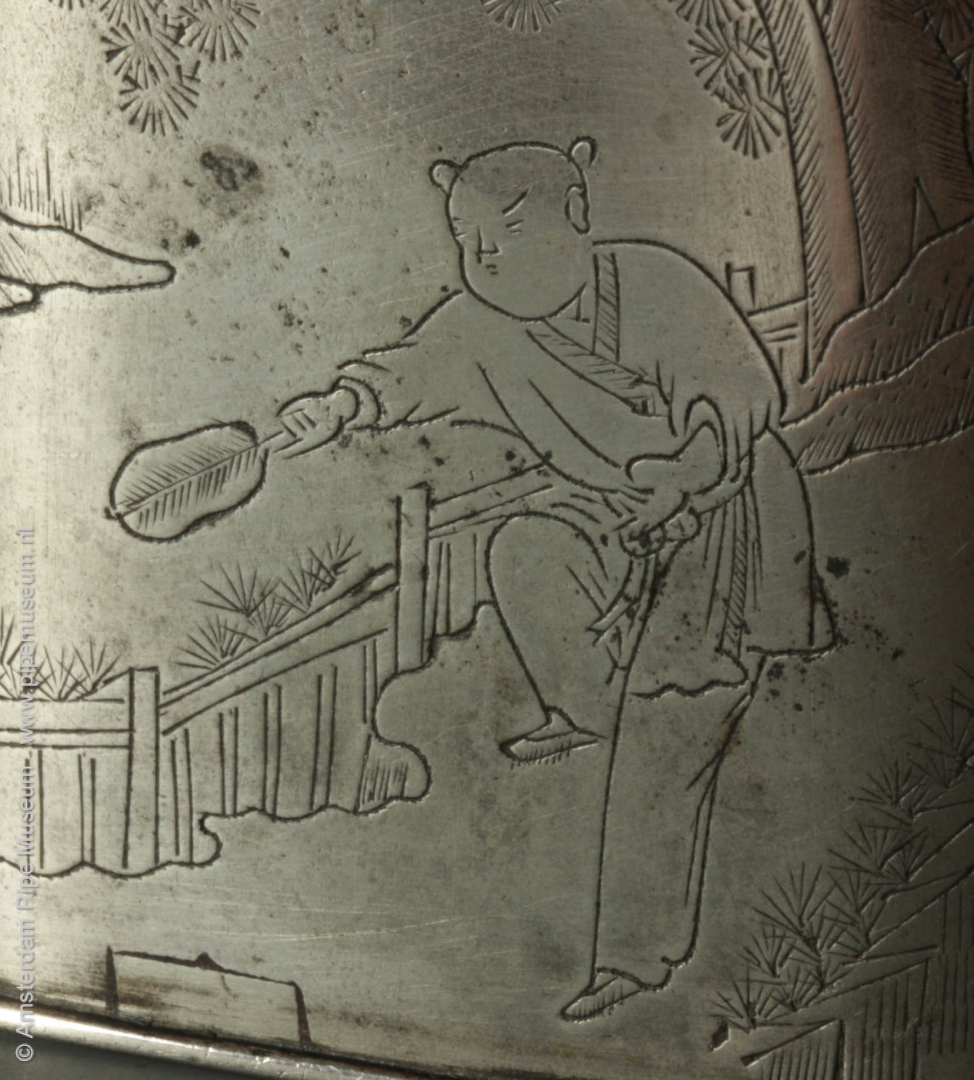
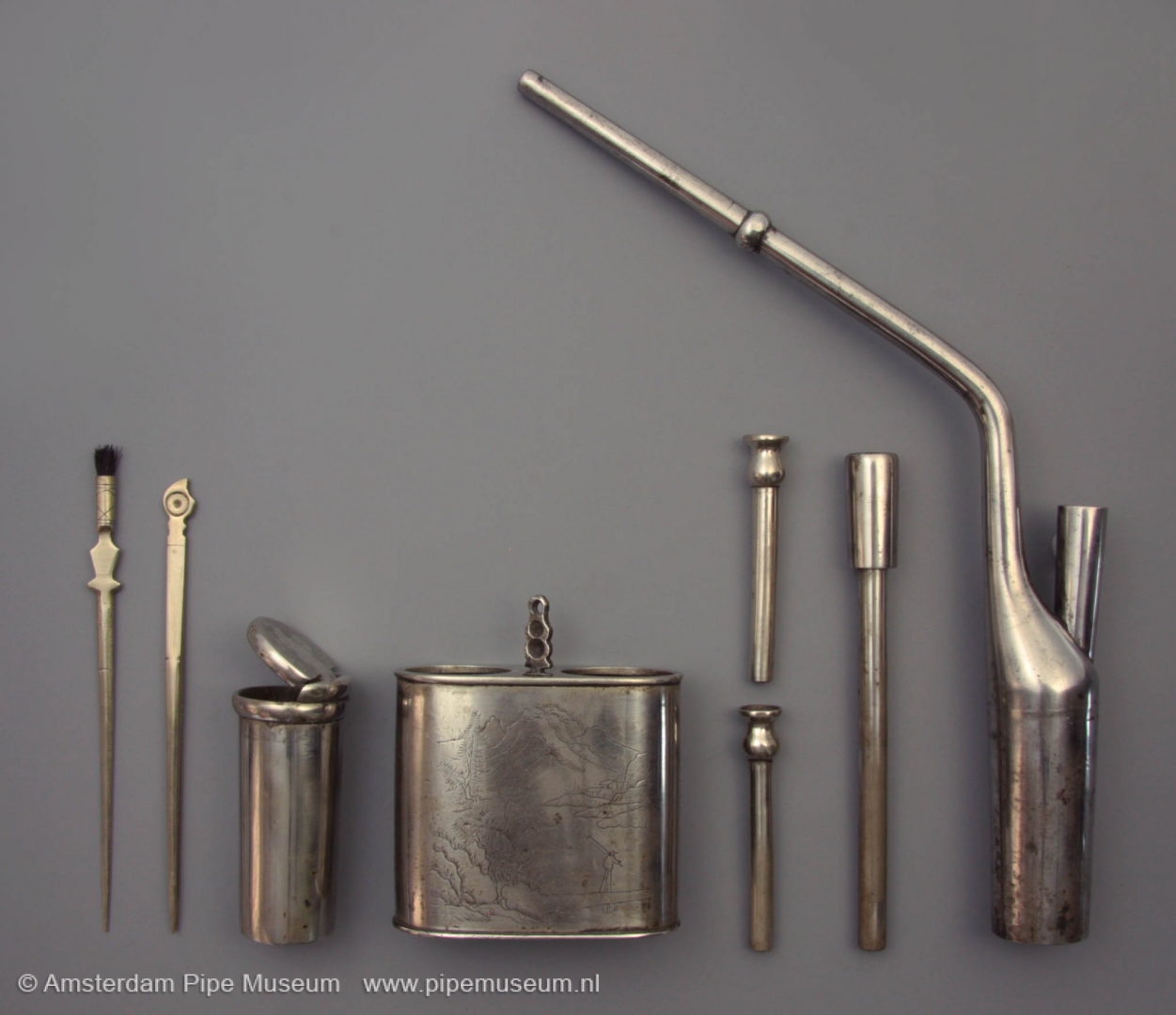
The material is pakton, an alloy of copper, nickel and zinc. The Chinese call it white copper, but when polished it has the shine of silver. The material is not very sensible to oxidation, but in the course of many years the shine vanishes. The metal is worked with great craftsmanship, especially the welded joints. After finishing the objects are generally engraved, especially on the surface of the container. Chinese landscapes are popular, in combination with characters that express poetic thoughts. This example has a décor of a pastoral scene, a girl with fan on one side, a man walking in an overwhelming landscape on the other side.
Many of these Chinese water pipes are signed, not by the maker but on request of the shopkeeper or trader who sold the pipe. Our example doesn’t have any signature. The fashion for these pipes emerges in the 1820’s and doesn’t disappear for a century. Thereafter production continues for the tourist market, even nowadays, although the craftsmanship is no more than a shadow of the past. In order to stimulate the sale the name opium pipe has been introduced and is in current use now all over the world. But for sure, this very practical smoking instrument is not for anything else than smoking tobacco.
Amsterdam, Pijpenkabinet collections Pk 19.616
A remarkable pakton pipe
Next to the more current water pipe described above, a longer, self-standing variety exists which is said to be developed earlier. This pipe, called pa-kong, is believed to date from the eighteenth century and continues to be produced into the twentieth century. These pipes are normally larger and more impressive than the water pipe in a container together with its tobacco box. Our example measures 55 centimetres in height. This makes it a pipe to be smoked at home, so it has no point of suspension to attach it to the belt.
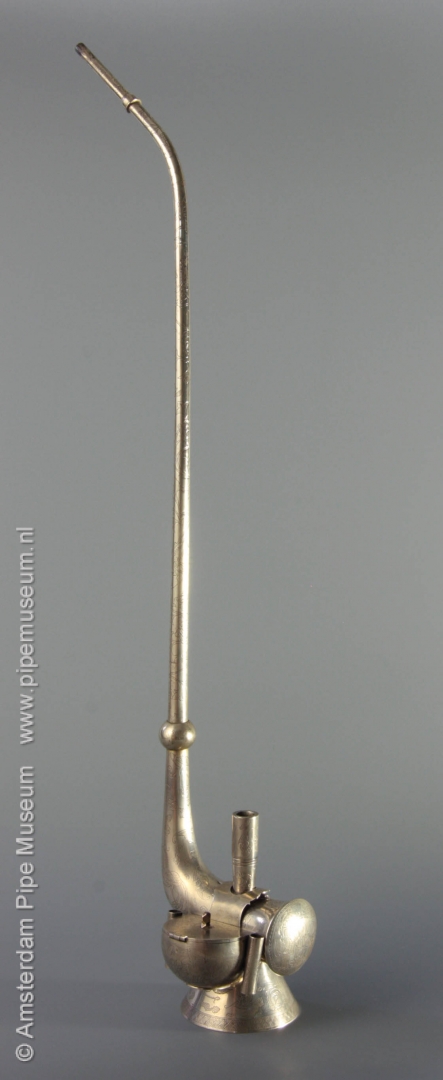


This pipe has been made of the same pakton alloy although the material is slightly greyer. More luxurious however is its engraving that goes all over the surface and shows fine flowers and leaves, alternated with some cranes and bats. The scene on the front of the water container is the most figurative: three standing Chinese and a girl with raised arms. The bottom holds an elaborate signature in Chinese characters. The signature shows sharper engravings than the decorations do, which raises the question that the decoration was possibly made by etching or hammering.
Although rare, also this water pipe is a serial product, according to literature made by the firm Chang-te-tai in Suchow. We date the pipe around 1900, but a few decades older is possible as well. The production of these objects was highly standardized and could continue unchanged for generations. It is a matter of experience to determinate the age, but by lack of enough comparable examples this is not easy.
This pipe has a matching tobacco box, to be attached onto the bowl, hanging on one of the sides of the water reservoir. The inside of the lid shows another signature in well engraved Chinese characters. Strange enough the decoration does not fully match the engravings on the pipe itself, but apparently this didn’t bother the Chinese clientele. It proves that the pipe and accessories are of serial production.
Amsterdam, Pijpenkabinet collections Pk 19.611
The farmers pipe made out of bamboo
The third acquisition is a less known kind of pipe since very few have survived, being made out of bamboo. One compartment of a thick bamboo rod forms the water container, closed by the two separation shields. The pipe stands by a flattened part of the round body. The mountings are made of pakton, this time somewhat yellow, showing that also this pipe is a serial product.
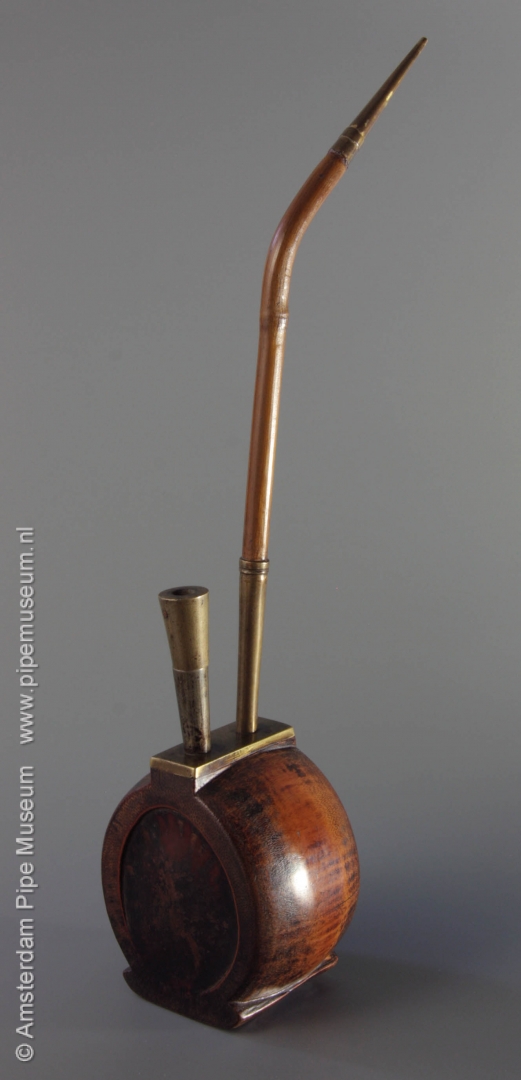
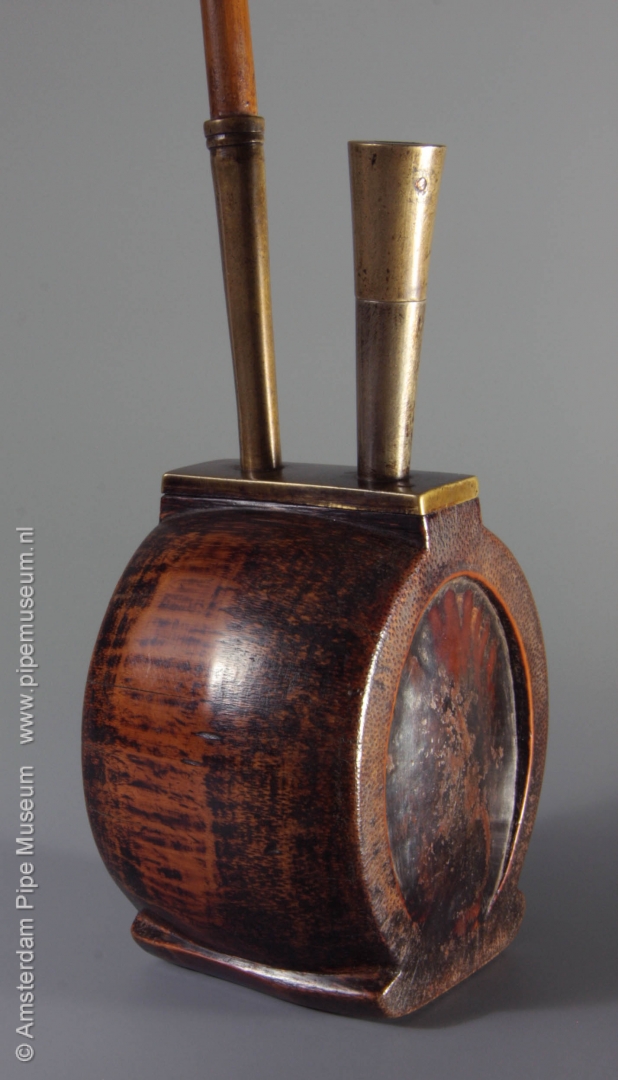
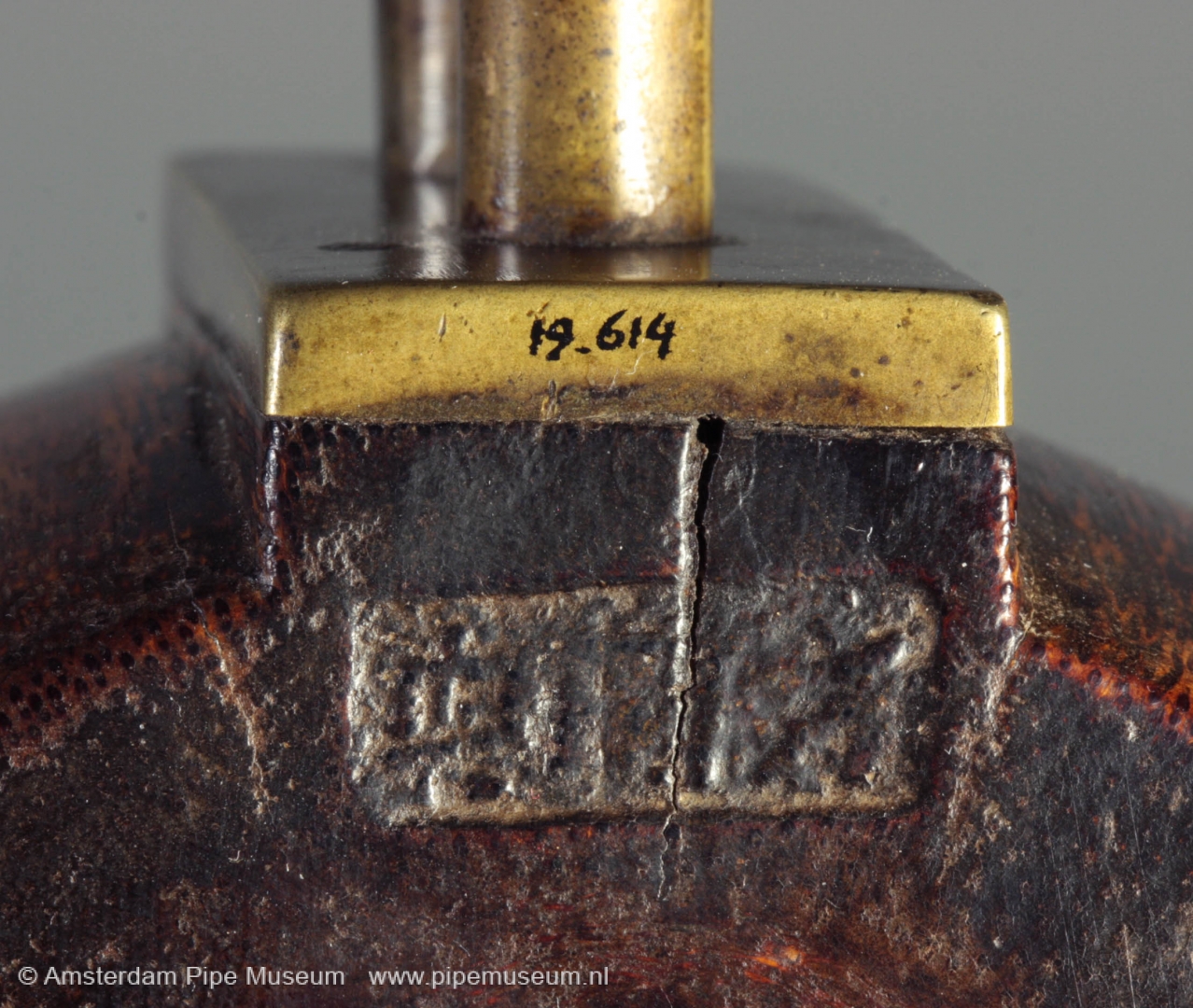
The joint where bowl and stem meet is quite solid with two stubs, one for the bowl, the other for the stem. The bowl itself is like other water pipes tubular ending in a long straight slightly conical stem going down into the water. In the bowl we always find a screen on which the tobacco is burnt. Usually this is worked out in fine geometrical patters such as a token of happiness of a trefoil. Here a simple straight line is brought into the bowl, functional but without any charm.
The pipe is provided with a long standing stem made out of bamboo. This stem is slightly bent, ending in a simple brass mouth piece. Quite unexpected the pipe is marked, three Chinese characters in a scare are printed into the wood, directly under the metal plate. The pipe is acquired in Hanoi, but this doesn´t mean that this is the place of origin. Asiatic objects can travel during a long time and over long distances before finding the destination of final sale for the best price.
Amsterdam, Pijpenkabinet collections Pk 19.614